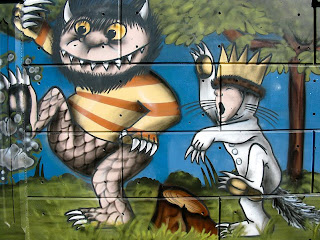Simple Shapes Over Time

I've recently joined a writing group here in Ottawa. It's a bunch of
English majors at Carleton who sit around, read each other's stuff,
and comment. I've been in writing clubs before, but I've never had
anyone bring in poetry. These people love poetry. I thought I wouldn't
have much to say, but it turns out I do, and I find these sessions
very rewarding. The interesting thing is that I find it more rewarding
giving feedback than getting. Anyway, this post is about
something I think I've discovered about time-based art as a result of
the comments I've made in this group.
I found that a great deal of my comments were along the following
lines: If you're going to do this kind of thing here, you need to be
consistent and do it throughout the work. Else it looks like a
mistake, or looks out of place, etc. Examples:
- writer made up one word in a poem
- writer has only one funny line
- writer has only one image of gritty realism
I thought about this, and came up with a general rule, that in short
works conventions you set up should be used consistently
throughout. But then I thought this wasn't quite right-- you can also
have build. I came up with the five simple shapes that I think
would be acceptable. They are depicted in the diagram.
So, for ascending there must be more and more of something as
the work progresses. e.g.
dishwater
pancakes
strawberries
powdered sugar
cocaine
Now this scarcely deserves the title poem, but it's simple enough for
this analysis.
What's happening in the above set of words is an ascending trend of
phenomological wonderfulness. It grows, so it kind of
works. "Cocaine," however, is qualitatively different from the other
things in the list, in my culture anyway, so it kind of breaks the
flow. It's so jolting that it's funny. That's okay, because the first
and last parts of something this short can have a special
status. Shakespeare's acts ended with rhymes, as did his chosen form
of poetry, the sonnet. It somehow seems appropriate for the end to
havce something different. If there were only one rhyme in the middle
it would look weirder.
There are other aspects to this poem, though. Each line is
consistently long. That is, the aspect of line length follows one of
the simple shapes. We could play with this:
several sinks of cold, dirty dishwater with lots of egg pans in it
pancakes with syrup, stacked a mile high
a big bowl of strawberries
powdered sugar
cocaine
Here the poem is similer but the line length has been turned from
consistent to descending. We could do the U-shape:
several sinks of cold, dirty dishwater with lots of egg pans in it
pancakes with syrup, stacked a high
strawberries
two pounds of white powdered sugar
six perfectly sized lines of the greatest, uncut, columbian cocaine
Notice this one works less well. The impact of the "cocaine" at the
end is damaged by the U-shape, which emphasizes "strawberries."
The u-shape is a little complicated for a poem this short.
I am reminded of the discussion in Hofstadter's Metamagical
Themas in which he talks about the grain size of a work of art. He
says the title of a novel is perhaps the most difficult thing to
translate, because you have so much meaning to transfer in so few
words. For example, translating the title of the novel All the
President's Men into French is difficult because it's a play on
the Humpty Dumpty rhyme, which the French might not have.
Similarly, if you have only a few pixels, it's difficult to represent
a circle. With thousands of pixels, a circle is clearly
recognizable. But if you're down to around 16, it looks, well,
pixelated. Similarly with short works I think the shapes in the
diagram are the only ones that will work because of the grain size.
Novels and feature-length films are another beast entirely. They are
long enough such that you can have multiple climaxes in the same
work. Each scene can have one of the simple shapes above, and there
might be several scenes per chapter.
In conclusion, I think if you're doing short works in any medium
(music, theatrical improvisation, short film, poetry, short stories,
etc.) you should be aware of all aspects of the work (tone, humor,
imagery, tempo, excitement, etc.) and make sure each one fits one of
the simple shapes.

Comments